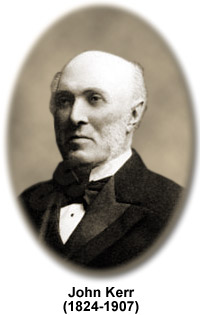John Kerr
(1824-1907)

John Kerr was a Scottish physicist that discovered the electro-optic effect that bears his name. Born in Ardrossan, Ayrshire, Kerr was the son of a fish seller and was educated in the village of Skye before attending Glasgow University, from which he received a Master of Arts in Physical Science with highest distinction. As a student, Kerr carried out research under his contemporary, William Thomson, better known as Lord Kelvin. The pair became close friends and remained so until their deaths in 1907. In addition to science, Kerr was interested in religion and he studied divinity before becoming an ordained minister of the Free Church of Scotland. Instead of practicing as a minister, however, he accepted a position as a mathematics and physical science lecturer at the Glasgow Free Church Teacher Training College, where he would teach for more than 40 years.
In 1875, John Kerr first reported on the electro-optic phenomenon that would come to bear his name. By utilizing a simple slab of glass with two holes drilled into its long axis so that approximately a one-half inch of solid glass separated them, an induction coil with two metal probes that were placed in the holes, and a polarizer and an analyzer aligned so that they were perpendicular to one another, Kerr demonstrated that when an electric potential is applied to an optical medium, light passing through it is doubly refracted. In other words, strong electric fields alter the molecular structure of glass and other substances, as Kerr later observed, so that the index of refraction (a measurement signifying the extent to which a beam of light is bent) in the direction of the electric field is different from the index of refraction of the vibration perpendicular to the field. As Kerr also found, the double refraction or birefringence that is induced is directly proportional to the square of the electric field to which it is exposed.
Kerrís original glass, induction coil, and crossed polarizer set-up is considered the first Kerr cell. Modern Kerr cells usually consist of a transparent shell containing nitrobenzene or some other liquid, rather than being composed of glass. The principle upon which they are based is still the same, however, and exposure to an electric potential allows light to pass through the analyzer, which is positioned so that it blocks all light under ordinary conditions. Pulses of light can be controlled so quickly with a modern Kerr cell that the devices are often used as high-speed shutter systems for photography and are sometimes alternately known as Kerr electro-optical shutters. In addition, Kerr cells have been used to measure the speed of light, are incorporated in some lasers, and are becoming increasingly common in telecommunications devices. The invention of lasers has led to the discovery of a special case of the Kerr effect, known as the AC Kerr effect, which is induced when the electric field a material is exposed to stems from light itself.
A year after his studies of the electro-optic Kerr effect, Kerr observed a similar phenomenon related to magnetic fields, which is now called the Kerr magneto-optic effect. To demonstrate this effect he reflected a plane-polarized light from the polished pole of an electromagnet. When Kerr turned the magnet on, the light became elliptically polarized. As he showed, the extent of the effect depends upon the position of the surface from which the light is reflected with respect to the magnetization direction as well as to the plane of the lightís incidence.
Another notable interest of Kerrís was the metric system, and the physicist greatly pushed for its adoption in his homeland. In 1864, following the publication of a pamphlet of his on the subject as well as the release of a book he wrote entitled Rational Mechanics, he was awarded an honorary doctorate degree. His later accomplishments were recognized by election into the Royal Society (1890) and the receipt of that organizationís prestigious award, the Royal Medal (1898).
